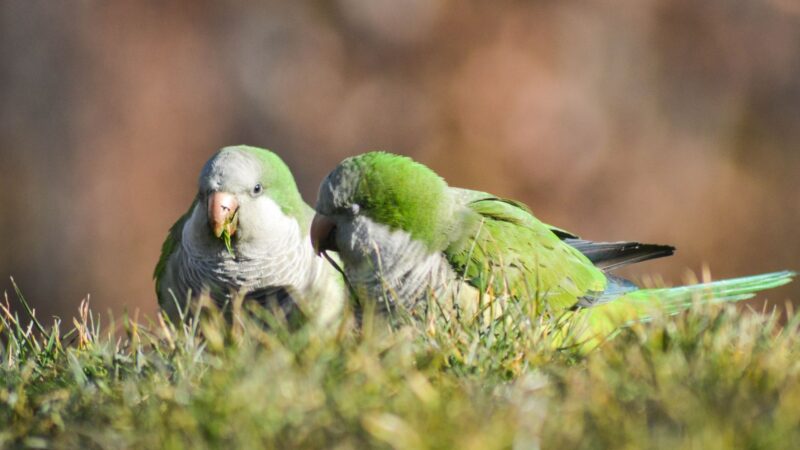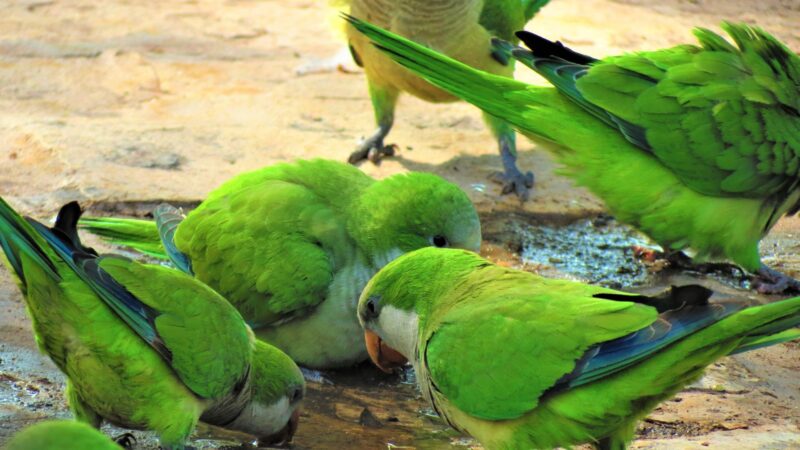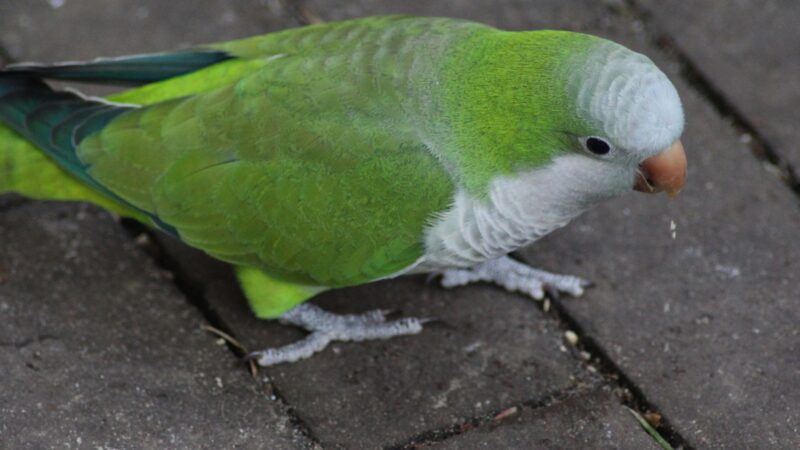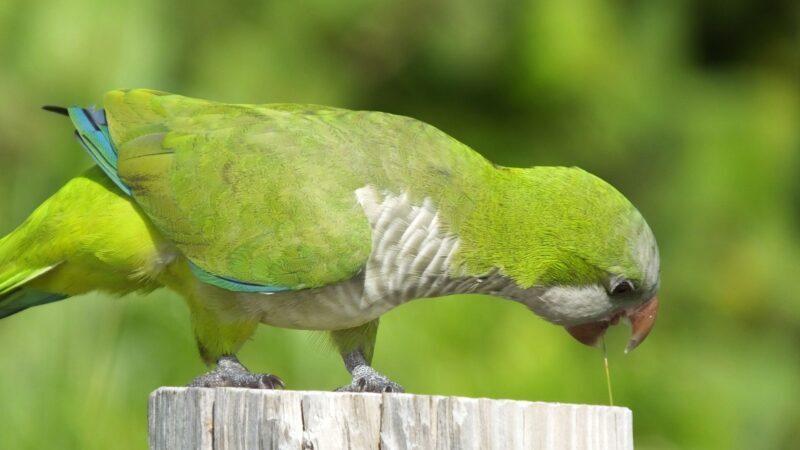Monk parakeets have been a thriving parrot species since their introduction in the 1960s. However, they have time and again proved how much of an invasive species they really are by causing structural damage and being a nuisance in human properties.
So, how to get rid of monk parakeets? Habitat modification, exclusion, installing and strategically placing scare devices in potential nesting and roosting sites, repellent application, and acquiring professional assistance can help get rid of monk parakeets.
By the end of this article, you’ll be armed with all the knowledge you need to deal with monk parakeets. Read further for more!
What Is a Monk Parakeet?

Also known as Quaker parrots, Monk Parakeets are medium-sized birds that are quite popular as house pets and are highly valued among bird breeders. Like other parrots, they are able to mimic human speech.
Identification
Monk parakeets are characterized by their overall green and gray plumage. They have large heads with grayish blue foreheads and large pale pink, hooked beaks. They also have brown eyes, gray legs, and long, tapered tails.
Appearance
Monk parakeets have stocky bodies with a length of 11 to 13 inches and a wingspan of 18 to 21 inches. They are about 90 to 120 grams heavy.
Voice and Sounds
Monk parakeets are raucous, boisterous birds with at least 11 different call varieties. They make loud squawking noises while flying and chattering noises while at rest. As was already mentioned, when kept in captivity, they can mimic human speech.
Reproduction
Breeding usually begins in late August and lasts until November. A single clutch of eggs can range from 3 to 8 eggs. Monk parakeets are able to produce up to 3 clutches in a single season. The male assists the female by feeding her every one to two hours as she solely incubates the egg.
Nesting
Since other parrots build their nests in tree cavities, this species is the only one in the parrot family that builds its nests primarily out of sticks. Monk parakeets build their nests with the help of little branches and twigs as well. This contributes to better insulation against harsh winter temperatures.
Additionally, they are also the only species that are colony nesters. Up to 20 nest chambers can be found in one nest, each holding many breeding pairs. In rare instances, it might even house 200 nesting structures.
Related: How to Prevent Birds Nesting in Roof? | Information and Control Guide
Behavior
Monk parakeets typically live in flocks, making them a highly social species. They are not easily scared by human presence. In order to forage for better food sources, some populations migrate during the winter.
Habitat
In general, monk parakeets are a rather adaptable species. But in the wild, they favor savannas, scrubby woodlands, and palm groves. On the other hand, they reside in public parks and other buildings in urban and suburban locations.
Problems With Aggressive Monk Parakeets

Monk parakeets are highly territorial and fiercely protective of their nests. They are known to harm and even kill other birds. Additionally, they also aggressively intimidate other birds when they’re hungry.
Why Should I Worry About Invasive Monk Parakeets?
Monk parakeets are considered invasive species. This is particularly true in places where they have been introduced. Here are the reasons why you should worry about them being a nuisance:
- Damage to electric utility facilities: These birds tend to build their nests on utility poles and other electricity structures. This leads to many problems such as power outages, equipment damage, and costly repairs.
- Damage to agriculture: No fruit, grain, and vegetable crops are safe from monk parakeets. In fact, they are known to cause significant crop losses of up to 45% if they are left undealt with.
- Damage to property: Monk parakeets can forage in urban and suburban areas, causing damage to homeowners’ crops and vegetation. Additionally, they also nest and roost around your homes.
- Disease carriers: These birds are vectors of the pathogen chlamydiae, which causes psittacosis. This is transmissible to humans through their fecal droppings.
- Competition: Aggressive as they are, monk parakeets compete with native bird populations for food and nesting areas. This may also lead to decreased population for native species.
- Noise pollution: Monk parakeets are quite noisy, producing loud and harsh squawking the whole day. A group of monk parakeets, consisting of about 8 to 10 birds, can be heard from a distance of 5 city blocks.
- Fire hazard: Their large, bulky nests consist of highly flammable materials like sticks and twigs, creating a potential fire hazard.
Related: How to Get Rid of Robins? | 8 Effective, Natural, and Humane Solutions
Should I Get Rid of Monk Parakeets?

It depends solely on your situation: if they have been causing damage or becoming a nuisance, it’s time for you to employ the necessary strategies in getting rid of them.
Related: How to Get Rid of Northern Mockingbird? | 7 Simple Ways
How to Get Rid of Monk Parakeets?
1. Habitat Modification
If monk parakeets are causing property damage, it’s time to make some simple modifications to your environment. The following methods will definitely encourage them to be a nuisance somewhere else:
Removing Food and Water Sources
Monk parakeets have a herbivore diet consisting mostly of fruits, seeds, grains, grasses, crops, and other vegetation. Dispose of any spills and wastes of these items as well as excess water to keep these birds away from foraging into your property. Additionally, keep your garbage bins securely closed.
Trim and Prune Trees and Shrubs
Trimming and pruning vegetation such as trees and shrubbery helps lessen the amount of potential nesting and roosting sites for the birds. You don’t have to thin these areas so dramatically, just do so sufficiently.
Change the Type of Seed Provided in Bird Feeders
Avoid feeding sunflower seeds, pumpkin seeds, safflower seeds, chia seeds, sesame seeds, and other smaller-sized seeds as these are some of the favorite food items of monk parakeets. Consider incorporating cracked corn and suet.
Switch to a Different Bird Feeder
If you can, replace your bird feeder with a type that excludes average-sized birds while still keeping smaller, desirable native bird species. You can use the following:
- Tube Feeders. Choose a plastic or glass tube feeder with shorter perches (made preferably of metal) and smaller feeding ports to accommodate smaller birds. You can also select those that have feeding ports designed for birds that hang upside down, such as chickadees and goldfinches.
- Caged Feeders. These are commonly designed to hold suet, nyjer, and peanuts. They have small opening holes that allow smaller birds such as nuthatches, chickadees, and woodpeckers to enter while preventing bigger birds from reaching the feed inside.
Related: How to Get Rid of Blackbirds From Bird Feeder? | 8 Effective Ways to Know
2. Exclusion
This method involves blocking the monk parakeets’ access to food and areas where they can nest and roost. Here are ways you can perform this strategy:
Install Netting
Cover potential nesting sites such as building crevices, ledges, overhangs, and rafters with netting made out of plastic or nylon. It is also helpful to cover fruit trees and crops to prevent the birds from eating them.
Using Bird Spikes
You can also strategically place bird spikes to prohibit the birds from nesting and roosting in specific areas around your property. You may also use it simultaneously with bird coils or bird spiders to increase your chances of successfully deterring monk parakeets.
Related: How to Keep Birds From Nesting on Porch? | The Effective Guide
3. Scare Devices
Use a combination of the following devices or products to scare away monk parakeets and prevent them from coming into your property:
Visual Scare Devices
This includes fake predators, silhouettes, eyespot balloons, flashing or strobing lights, reflective tape, aluminum pie plates, and bird lighthouses.
Sound Scare Devices
Monk parakeets are easily startled by the noise. Although time-consuming, you can simply beat metal pans together and other objects that can make loud noises to deter birds away from your property.
Other scare devices are distress call sound systems and ultrasonic sound systems. Choose a product that allows a wider range and higher frequencies.
Physical Scare Devices
Motion-sensitive water sprinklers can be used to startle wandering or foraging monk parakeets that enter your property. Make sure to purchase a product that has extensive coverage and low to medium water pressure.
Related: How to Get Rid of Barn Swallows? | 8 Prevention Tips
4. Repellents
You can also use sticky repellents that can be applied on roosting and nesting areas to keep the birds from even stepping on these locations. Make sure to put masking tape on the area first before application to make it easier for you to remove the repellent.
- Mitigates Birds Effectively: Bid farewell to birds roosting on...
- Versatile Bird Proof Gel: Whether it's windowsills, building...
- Maintains Property Aesthetics: Our clear gel cuts cleanup costs,...
- Reliable Bird-Resisting Gel: Crafted to discomfort birds without...
- Easy Application: Your ultimate ally in bird control, our gel is...
- Transparent bird gel
- Effective for both small and large pest birds, and is low profile...
- Effective at wide temperature extremes, 15 to 200 degree...
- Economical and effective
- Available in a standard 10 ounce caulking tube
5. Professional Help
If the methods above are unsuccessful at getting rid of monk parakeets in your property, it’s time to call for professional pest control services.
Are Monk Parakeets Good Pets?
Yes. They are affectionate and charming towards humans, loving to spend time with their owners. They are also highly intelligent, loyal, and gentle. As such, they make great companions!
Why Is My Monk Parakeet Acting Violent?

Territorial aggression, hormonal changes, fear, need to assert dominance, past traumatic experiences, lack of socialization, stress, and underlying medical conditions are examples of common reasons.
How to Get Rid of the Aggressive Behavior of Monk Parakeets?
To control their aggressive behaviors mentioned earlier, you can employ the following strategies:
- Remove anything in their environment that could stress them out.
- Make them follow a consistent routine daily.
- Provide sufficient mental stimulation by training them to do tricks and providing a wide range of toys. Make sure they get proper physical exercise as well.
- Take some time to talk and interact with them. They value this the most as they are a highly social species.
- For more information, book a consultation with a local wildlife specialist or avian veterinarian.
Related: How to Get Rid of English Sparrows | Practical Strategies and Methods
List of Sources
All About Birds. Monk Parakeets.
Avery, M. L., & Lindsay, J. R. (2016). Monk Parakeets.
Boren, J., & Hurd, B. J. Controlling Nuisance Birds in New Mexico.
Columbia. (n.d.). Monk Parakeet (Myiopsitta monachus).
Davis, L. R. (1974). The Monk Parakeet: A Potential Threat to Agriculture.
Eberhard, J. R. (1998). Breeding Biology of the Monk Parakeet.
- How to Get Rid of Copperheads | Practical Guide - August 27, 2023
- How to Get Rid of Corn Snakes | What Makes Them Aggressive? - August 27, 2023
- How to Get Rid of Alligators | Safety Measures and Removal Methods - July 16, 2023



